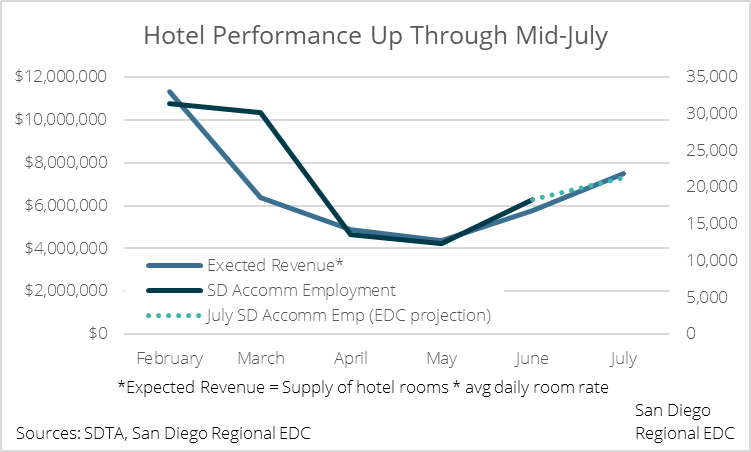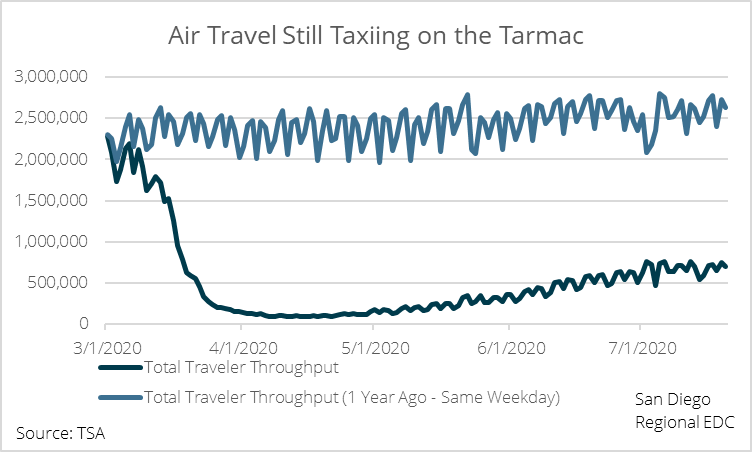THE TAKEAWAYS
- The July jobs report is likely to look better than it should because of the timing of data collection by the Labor Department.
- San Diego’s tourism sector continued to recover through mid-July, before renewed shutdown orders were given, but U.S. air travel remains well below year-ago levels.
- Any setback from last week’s partial shutdown is unlikely to show up until the August jobs numbers are released.
First, it’s important to note that the May employment report was revised 7,300 lower, making for a net 46,700 positions added in June to May’s pre-revised figure—almost exactly matching our prediction for 45,000 net new positions.
June’s employment report also aligned with expectations; San Diego employers added 54,000 jobs last month. The additional jobs lowered the local unemployment rate from 15.2 percent (revised higher from an initial estimate of 15.0 percent) to 13.9 percent. However, this is still nearly 3 percentage points higher than the national rate of 11.2 percent in June, due in large part to the higher concentration of food services, retail, and tourism in San Diego, which were ravaged by the COVID-19 downturn.
Even though June’s numbers were just released, it’s never too early to look ahead to the July report. With San Diego partially shutting down again last week, conventional wisdom suggests that the July report will show a fresh spate of job losses. However, timing is key. The July employment figures will be estimated using data collected the week of July 12, 2020. Therefore, any layoffs from last week’s move to shut down bars, indoor dining areas, museums, zoos, and hair salons will probably not be picked up in July’s report. In other words, the July employment report will most likely look better on the surface than it would had the data spanned through the end of the month—wrongfully implying that the regional economy fared better than it actually did in July.
TOURISM FORGES AHEAD…
Local tourism has a long road ahead of it before it fully recovers, but hotel occupancy data produced by the San Diego Tourism Authority through July 11, 2020 show that both the demand for and supply of hotel rooms has continued to rise since bottoming in April. Average daily rates for rooms in the region have also continued to increase. We can anticipate changes to accommodation employment given its tight relationship to the room supply and daily rental rates, since hotels need to be sufficiently staffed to manage tourist traffic in any given week.
Before the COVID-19 outbreak, San Diego hotels employed 31,400 workers. That number was slashed by more than 60 percent after statewide shutdown orders in March. The industry added back 5,900—or roughly one in three—of the jobs lost to COVID-19 shutdowns in June. And the tight relationship between hotel occupancy, room rates, and employment suggests that accommodation services could be shown in July to have recouped another 2,500 to 3,000 jobs, bringing total industry employment back above 20,000 for the first time since March.

…BUT…
TSA data shows a painfully slow recovery in air travel, with throughput at U.S. airports over the past week down an average of 74 percent from a year ago. Given San Diego’s stature as an international tourism destination, the lack of jet-setter traffic through airports means that San Diego hotels will face an uphill battle to fill open rooms. This underscores the tenuous nature of local tourism’s comeback.

LOOKING AHEAD
National employment numbers will shed some more light on what we can expect to see locally in the July jobs report. However, any positive takeaways from that report should be taken with a grain of salt, since the most recent round of local shutdowns will undoubtedly mean that companies have to once again let go of employees. The magnitude of job losses will hinge on the duration of the current shutdown, which is contingent on a number of metrics, including the rate of positive COVID-19 tests across the county, number of community outbreaks in a given week, and local hospital and ICU capacity, just to name a few.
Taken together, July’s employment report is more than likely to present another round of job gains, but August’s report is almost certain to reveal a setback in the recovery—although, how big of a setback won’t be clear for at least another several weeks. Moving forward, job training and retraining services will be increasingly vital to the long-term health of the economy, since temporary layoffs are more likely to become permanent ones in the coming months if businesses remain limited to partial operating capacity.
This is not to say that we advocate reopening at the risk of public health—instead, we are advocating for a path to opportunity for San Diego’s most vulnerable workers to reduce their reliance on inherently volatile industries and occupations.
EDC is here to help. You can use the button below to request our assistance with finding information, applying to relief programs, and more.
You also might like: